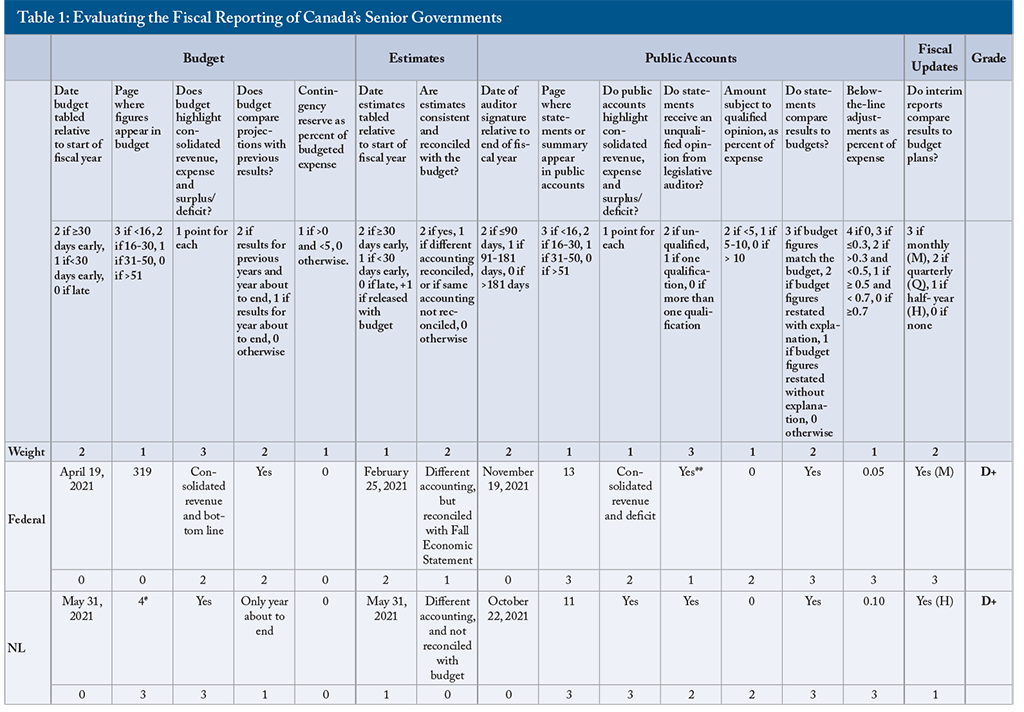The Study in Brief
Canada’s senior governments raise and spend huge amounts, and have legally unlimited capacity to borrow when their expenses exceed their revenues. Holding public officials accountable for their spending, taxing and borrowing is a foundational task in a system of representative government. Citizens have the right to know, and elected representatives have duties to them.
While much of the financial information presented to legislators and the public by Canada’s federal, provincial and territorial governments has improved over time, the C.D. Howe Institute’s 2022 report card reveals shortfalls. Too many governments present information that is opaque, misleading and late.
This report card on the usefulness of governments’ budgets, estimates and financial statements assigns letter grades that reflect how readily an interested but non-expert user can find, understand and act on the information they should contain. In this year’s report card – which covers year-end financial statements for fiscal year 2020/21, and budgets and estimates for 2021/22 – Alberta and Yukon topped the class with grades of A and A- respectively. Nunavut, Saskatchewan, and New Brunswick each scored B+, Ontario scored a B, and Quebec scored a B-. Prince Edward Island scored a C+, and Nova Scotia scored a C. The federal government and Newfoundland and Labrador got grades of D+. Manitoba, British Colombia and the Northwest Territories were at the bottom of the class with grades of D.
In some respects, this mixed picture represents improvement. Two decades ago, none of Canada’s senior governments budgeted and reported revenues, expenses and surpluses or deficits on the same accounting basis; today, presentations consistent with public sector accounting standards are the rule. Canada’s governments, however, can do better.
The Northwest Territories could improve its grade with better budget presentations and interim updates. Alberta could improve its grade by releasing its estimates in one document. Newfoundland and Labrador could improve its grade with a more timely release of its budget and estimates. Most senior governments could improve their grades with more timely releases of public accounts: only two – Alberta and Saskatchewan – released theirs within 90 days of the end of the fiscal year. The federal government, which earned a grade of F in last year’s report card, mainly because of its egregious and unprecedented failure to produce a budget, was slow to release its public accounts because it reopened the books – another worrying precedent from a government that should be setting the standard for transparent, reliable and timely financial information.
Massive increases in spending and borrowing by governments in response to the COVID-19 crisis, and ambitions for new social programs and industrial policies in its aftermath, have raised the stakes – and, unfortunately, coincided with some serious backsliding in the transparency and timeliness of financial information.
This annual report card hopes to encourage further progress and limit backsliding. Canadians can get more transparent financial reporting and better fiscal accountability from their governments, if they demand it.
Canada’s federal, provincial and territorial governments loom large in the Canadian economy and in Canadians’ lives. Even before COVID-19 prompted major increases, their budgets and spending estimates for the 2021/22 fiscal year prefigured more than $1 trillion in revenue and expense – around 41 percent of gross domestic product, or more than $26,000 per Canadian.
They use this money to provide services and transfer payments in areas such as health, education, national defence and policing, income support and business subsidies. They tax Canadians’ incomes from work and saving, and they tax spending on most goods and services. Over time, their aggregate expenses have exceeded their revenues, resulting in negative net worth. At the end of the 2020/21 fiscal year, their accumulated deficits totaled $1.4 trillion and, during that year, they paid more than $49 billion in interest.
Taxpayers’ and citizens’ ability to monitor, influence and react to how legislators and officials manage public funds is fundamental to representative government. We need to check that legislators and government officials are acting in the interest of the people they represent, and we need to respond if we conclude that they are acting negligently or in their own interest. Financial reports are key tools for monitoring governments’ performance of their fiduciary duties.
The audited financial statements Canada’s senior governments publish in their public accounts after each fiscal year provide key information. In particular, their statements of operations show their revenues and expenses during the year, and the difference between them: their surpluses or deficits. Their statements of financial position show their assets – both financial assets and capital assets like buildings – and their liabilities. The difference between their assets and liabilities – their net worth – reflects their accumulated surpluses and deficits over time and captures their capacity to provide services now and in the future.
Budgets provide similar information prospectively. Citizens and taxpayers, and the legislators who represent them, can examine the budget a government presents at the start of the fiscal year – notably, its commitments with respect to revenues and expenses and the projected surplus or deficit. The budget should also show the change in net worth that will result from the projected surplus or deficit, so users of the budget will understand the budget’s implications for the government’s capacity to deliver services at the end of the period.
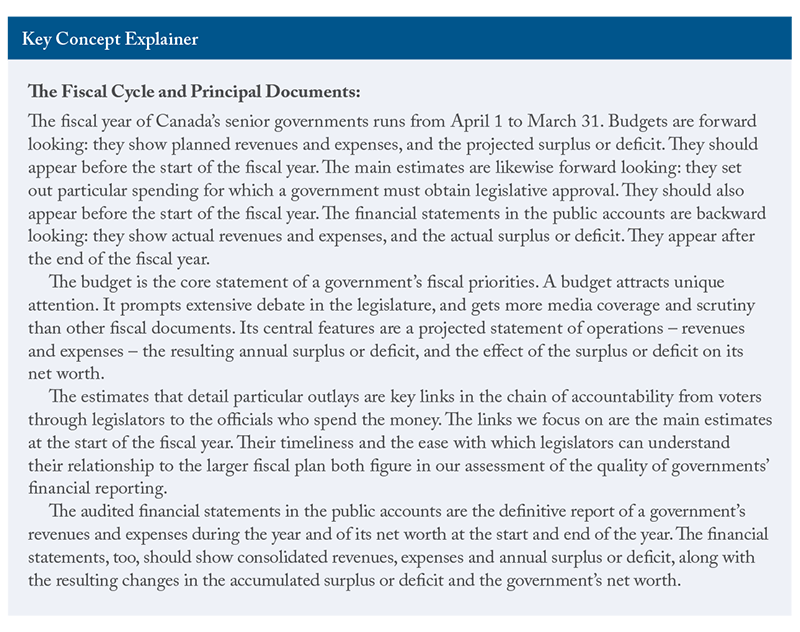
The estimates governments present to legislatures show spending for which the government must obtain legislative approval each year. The estimates’ scope is narrower than the expenses shown in budgets and financial statements – excluding items that do not require votes, such as Crown corporations, and ongoing expenses, such as interest. But they are nevertheless central to legislative control of public money. Legislators should see individual programs in the estimates in the context of the overall plan for revenues and expenses, with its implications for the surplus or deficit and changes in future service capacity.
The C.D. Howe Institute’s annual report on the fiscal accountability of Canada’s senior governments focuses on the relevance, accessibility, reliability and timeliness of these documents. It is not about whether governments spend and tax too much or too little, whether they run surpluses or deficits, or whether their programs succeed or fail. It is about whether Canadians can get the information they need to form opinions on these issues and correct any problems they discover. The letter grades in this report reflect our judgement about whether governments’ budgets, estimates and financial statements let legislators and voters understand governments’ fiscal plans and hold governments to account for fulfilling them.
We put ourselves in the place of an intelligent and motivated but non-expert reader – a legislator, journalist or voter. We ask how readily that reader can find the relevant numbers in each document, and use them to make straightforward comparisons. For example, can the reader compare the revenues and expenses projected and approved by legislators before the start of the year with the revenues and expenses of the prior year? Can the reader compare the revenues, expenses and change in net worth published after year-end with the budget’s projections?
With respect to the budgets and estimates for the 2021/22 fiscal year, and the year-end financial statements for the previous 2020/21 fiscal year – the documents relevant for this report card – the reader would be able to answer such questions about Alberta and Yukon relatively easily. These jurisdictions displayed the relevant numbers early in their documents. They used consistent accounting and aggregation in all their documents. They provided tables that reconciled results with budget intentions, and published in-year updates. They produced timely numbers. They presented their 2021/22 budgets before the start of the fiscal year and presented their main estimates at the same time. Alberta was one of only two senior governments to release its 2020/21 public accounts within ninety days of the end of the fiscal year.
Our reader would have a tougher time with the documents of other governments. Some governments’ budgets, estimates and/or public accounts used inappropriate and inconsistent accounting and aggregation, impeding understanding of the documents and comparisons among them. Some governments buried their consolidated revenues and expenses hundreds of pages into a document or even hid them in separate documents.
Timeliness is uneven among Canada’s senior governments. Some presented budgets after the start of the fiscal year, with money already committed or spent. Some did not present their main estimates simultaneously with their budgets. Some did not release their year-end financial statements until most of the following fiscal year had elapsed, undercutting attempts to compare recent performance against a definitive baseline.
Although the principal focus of this report is the budgets and reports published in the most recent complete fiscal cycle, we have two comments about the past and the future.
Looking back, we are glad to report that, over time, and notwithstanding the federal government’s egregious failure to present a budget in 2020, the quality of the financial information provided by Canada’s senior governments has tended to improve. Two decades ago, none of Canada’s senior governments budgeted and reported consolidated revenues, expenses and surplus or deficits on the same accounting basis; lately, consistent presentations that conform with Public Sector Accounting Standards are normal.
Looking forward, we provide a preview of the scores for the fiscal year 2022/23 budgets and estimates. On this front, the news is mixed. The provinces and territories were generally faster in the most recent budget cycle, with eight senior governments presenting their budgets earlier than last year. Based on the information to date, Alberta is on track for an A+ in our 2023 report card. Saskatchewan and Yukon are on track for grades of A-. Sadly, and significantly, the federal government is on track only for a grade of D+.
A key aim of this annual survey is to limit backsliding and to encourage further progress. The deficiencies we highlight in this report are fixable, as improvements by the leading jurisdictions show. Canadians can get good financial reporting from their governments and they should insist on it.
Measuring Fiscal Accountability
Financial documents are tools to help people make decisions. To be useful, they must be accurate and complete. They must help users find and interpret the key numbers. In the case of governments, an essential minimum is that a reader who is motivated and numerate, but not an expert in accounting, can easily find consolidated revenues and expenses, and the resulting surplus or deficit, in budgets and financial statements. And they must be timely. Our focus on these attributes complements other measures of fiscal transparency, including the Organization for Economic Co-operation and Development’s Best Practices for Budget Transparency (OECD 2002) and the Open Budget Survey (International Budget Partnership 2020).
Interpreting the Principal Documents
Comparing the principal documents should be straightforward. As the Public Sector Accounting Board expresses it:
The actual-to-budget comparison is meaningful when the budget:
(a) is prepared on the same basis of accounting (i.e., accrual accounting),
(b) follows the same accounting principles (i.e., the standards in the PSA Handbook),
(c) is for the same scope of activities (i.e., includes all components, where applicable, and all controlled entities) and
(d) uses the same classification (i.e., revenue by type and expenses by function or major program) as the financial statements. (PSAB 2021, 34.)
A clear comparison will let a motivated non-expert answer such questions as how close last year’s results were to last year’s plans, and what increases or decreases in revenues and expenses this year’s budget would produce relative to last year’s results. An obscure comparison will force even an expert to work hard to answer such questions, and stymie a non-expert at the outset.
Although the main estimates do not cover all expenses captured in a government’s budget or financial statements, similar logic applies to them. Governments that present estimates simultaneously with their budgets, and provide clear reconciliations of the amounts they are asking legislators to approve with the overall fiscal plan, are more transparent about their intentions and spending decisions than governments that do not.
Many governments also produce interim fiscal reports during the year. These show performance relative to their budgets, and some provide updated financial projections for the year. This interim information can improve understanding of how events affect public finances, and can foster early action if things are going problematically off course. Our survey also looks at the frequency of these reports.
To quantify the quality and accessibility of the information in the budgets, estimates, and financial reports of Canada’s senior governments in the 2021 and 2022 fiscal cycles, we address the principles just discussed using specific criteria. Our scoring range on each criterion reflects the granularity we think appropriate to distinguish good from bad performance. The scoring ranges do not affect the weight of each criterion in the overall grade; the weight reflects our judgement of each criterion’s relative importance to overall transparency and accountability.
Timeliness
Since spending without authorization by elected representatives violates a core principle of representative democracy, legislators should have sufficient time to consider the government’s fiscal plan, and vote on the budget before the start of the fiscal year. We awarded a score of 2 to governments that presented their 2021/22 budgets 30 days or more before the start of the fiscal year (April 1st), 1 to governments that presented their budgets less than 30 days before the start of the fiscal year and 0 to governments that presented their budgets after the start of the fiscal year.
Main estimates, like budgets, should be timely. Legislators ideally would get them with the budget and, in any event, early enough to consider them before the start of the fiscal year. As with budgets, we awarded 2 to governments that presented their 2021/22 estimates 30 days or more before the start of the fiscal year, 1 to governments that presented them less than 30 days before the start of the fiscal year and 0 to governments that presented them after the start of the fiscal year. We awarded a bonus point to governments that tabled their main estimates simultaneously with their budgets.
Timely release of year-end financial statements also matters. Earlier release helps legislators and the public understand and react to deviations of results from plans. A more ambitious schedule for release also encourages faster gathering of information – helpful for interim results for the year about to end and the budget baseline. We used the date of the auditor’s signature on the financial statements. That is not ideal, because governments sometimes release the statements and/or the public accounts some time after the auditor signs, and the public accounts contain useful additional information. The date of the auditor’s signature is easier to verify than the date of release, however, so we used it for transparency’s sake. We awarded a score of 2 to governments with auditor signatures no more than 90 days after year-end (March 31st), 1 to governments with signatures more than 90 days but no more than 181 days after year-end, and 0 to governments with signatures more than 181 days after year-end.
Some readers may feel that our timeliness criteria are too demanding for the circumstances affecting the 2021/22 budgets and the 2020/21 financial statements. While the pandemic made economic and fiscal projections – including some forward-looking disclosures in financial statements – unusually hard, accountability should not depend on circumstances.
Interim updates provide timely information about how the fiscal results are unfolding relative to the budget. We awarded 3 to governments that provided monthly updates, 2 to governments that provided quarterly updates, 1 to governments that provided only half-year updates and 0 to governments that provided none.
Placement of Key Numbers
Key numbers should be easy to find and identify. Readers of budgets and public accounts documents should not need to sort through reams of extraneous and potentially misleading material. Putting consolidated revenues, expenses, and the surplus or deficit up front reduces the chance that a user will give up, or find wrong numbers before finding the right ones.
We reference the physical budget books and public accounts, or their electronic PDF equivalents, because web pages and links among documents are sometimes ephemeral and not clearly dated, and can confront users with hard-to-quantify navigational challenges. Our count begins with the first physical or electronic page of the document, omitting pages containing tables of contents and lists of tables and figures, since those help readers navigate the document.
For both budgets and public accounts, we awarded 3 to governments that showed their consolidated revenues, expenses and bottom-line numbers within the first 15 pages of the documents, 2 to governments that showed them 16-30 pages into the documents, 1 to governments that showed them 31-50 pages into their documents, and 0 to governments that showed them more than 50 pages into their documents. We do not scale our scores according to the overall length of the documents – by using percentages, for instance – because a longer document should not excuse late placement of the numbers.
Reliability and Transparency of Numbers
With respect to both budgets and public accounts, we first ask if the reader can readily find consolidated revenues, consolidated expenses, and the surplus or deficit. These three figures capture the items that add to a government’s capacity to deliver services during the year and subtract from its capacity to deliver services during the year, and the resulting change in its capacity to deliver services during the year. They should do that with respect to everything the government controls – the entire “reporting entity.” Governments that omit items such as amortization of capital, debt-servicing costs or pension expense, or move money in and out of special-purpose accounts, obscure this essential information. In scoring both budgets and public accounts, we awarded 1 point for each of consolidated revenue, consolidated expense, and consolidated surplus or deficit, for a maximum of 3 points.
With respect to the public accounts, a vital question is whether the relevant legislative auditor gave a qualified opinion about their adherence to PSAS. We awarded 2 to governments that received an unqualified opinion on their 2020/21 financial statements, 1 to governments that had one qualification, and 0 to governments that had more than one qualification.
Financial results are easier to understand if the difference between revenues and expenses – the surplus or deficit – relates straightforwardly to the change in the government’s net worth, representing its capacity to deliver services, over the fiscal year. A line such as “other comprehensive income or loss” between the year’s surplus or deficit and the associated change in the accumulated surplus or deficit loosens that link.
Our decision to penalize these below-the-line adjustments is open to objection on the grounds that PSAS allow or mandate them in some circumstances. They often show gains and losses of government-owned enterprises. That example illustrates the justification for such lines: gains or losses on investments in Crown corporations that governments do not control directly are different from revenue and expense related to decisions about taxes and spending by legislatures. It also illustrates why they are problematic: governments experiencing such gains and losses have undertakings that expose taxpayers to risks – changes in the government’s capacity to deliver services – that they cannot budget for or control. Such exposure undermines fiscal accountability.
Even when used correctly, below-the-line entries indicate an accountability problem: a gap between budget decisions and ultimate changes in a government’s service capacity. Moreover, governments may not reliably honour the principle that such adjustments should relate to matters the budget could not have anticipated. Our concerns about below-the-line adjustments led us to award the following scores: 4 to governments with no such adjustments in their 2020/21 financial statements, 3 to governments with adjustments with an absolute value not exceeding 0.3 percent of expenses, 2 to governments with adjustments with an absolute value between 0.3 and 0.5 percent of expenses, 1 to governments with adjustments equal to or greater than 0.5 but less than 0.7 percent of expenses, and 0 to governments with adjustments equal to or greater than 0.7 percent of expenses.
Budgeting is inevitably uncertain, and governments can deal with uncertainties in their projections in various ways, some more problematic for transparency and accountability than others. Governments sometimes build in cushions by shading their economic forecasts and/or revenue projections down, or shading their expense projections up. These approaches are opaque. An explicit prudence or contingency reserve is more transparent, but if such cushions are large, they give governments scope to spend well beyond what the legislature formally approves in the main estimates, undermining accountability. Accordingly, we rewarded governments for including an explicit prudence cushion or reserve in their budgets, as long as it was not too big. We awarded 1 to governments that included a reserve in their fiscal projections if the reserve was less than 5 percent of budgeted expenses, and 0 to governments that presented no reserve or presented one that was 5 percent or more of budgeted expenses.
Users of budgets will learn more if they can readily compare budget plans with results as published in previous financial statements and with the projected results for the fiscal year about to end.
Users of estimates should be able to understand how the specific items they might approve relate to projected consolidated expenses in the budget. We awarded 2 to governments that presented a single document with estimates that matched the budget and reconciled with projected consolidated expenses. We awarded 1 to governments that presented estimates that did not match the budget but provided a clear reconciliation with projected consolidated expenses, and to governments that presented estimates with accounting that matched the budget but did not provide a clear reconciliation. We awarded 0 to governments that presented estimates that did not match the presentation in the budget and did not reconcile them with projected consolidated expenses.
Users of public accounts will learn much from an informative comparison of the year’s results to the budget projections. Governments should show budget comparisons next to the statement of operations in their year-end financial statements, and all the senior governments did that in the 2020/21 fiscal year. These comparisons are most informative when the final budget numbers match those in the original budget. When financial statements present comparisons with budget numbers restated from the original budget projections, the comparison is less informative. Therefore, we awarded 3 to governments that showed budget numbers in their financial statements that matched those in the budget itself. We would also have awarded 3 to governments that showed budget numbers restated to make them more consistent with PSAS, but no such instances occurred this year. We awarded 2 to governments that showed restated budget numbers, but explained the restatements. We awarded 1 to governments that showed restated budget numbers, but did not explain the restatements. We would have awarded 0 to any government that did not provide budget comparisons in its financial statements.
The 2022 Report Card
To produce an overall grade, we standardized the scores for each criterion to be between 0 and 1,
Alberta received an A grade and Yukon received an A-. Alberta was one of only two governments to release its public accounts within 90 days of year-end. Both Alberta and Yukon presented numbers early in their documents. Both used consistent accounting, and Yukon used consistent aggregation across all three documents.
In the B tier were Nunavut (B+), Saskatchewan (B+), New Brunswick (B+), Ontario (B), and Quebec (B-). Nunavut released its budget and estimates well before the start of the fiscal year; however late public accounts and estimates that were unreconciled and inconsistent with the budget adversely affected its score. Saskatchewan produced timely financial statements, but was late with its budget and estimates. New Brunswick’s budget and estimates were not as early as it has often achieved in the past, and the lack of historical comparisons and contingency reserves in its budget hurt its score.
Ontario had a relatively large below-the-line adjustment and produced its estimates after its budget. Moreover, and uniquely among Canada’s senior governments, Ontario did not provide an easily accessible PDF document for its 2021/22 estimates. Ontario’s estimates did not include a reconciliation with the budget, which had a different figure for consolidated expenses.
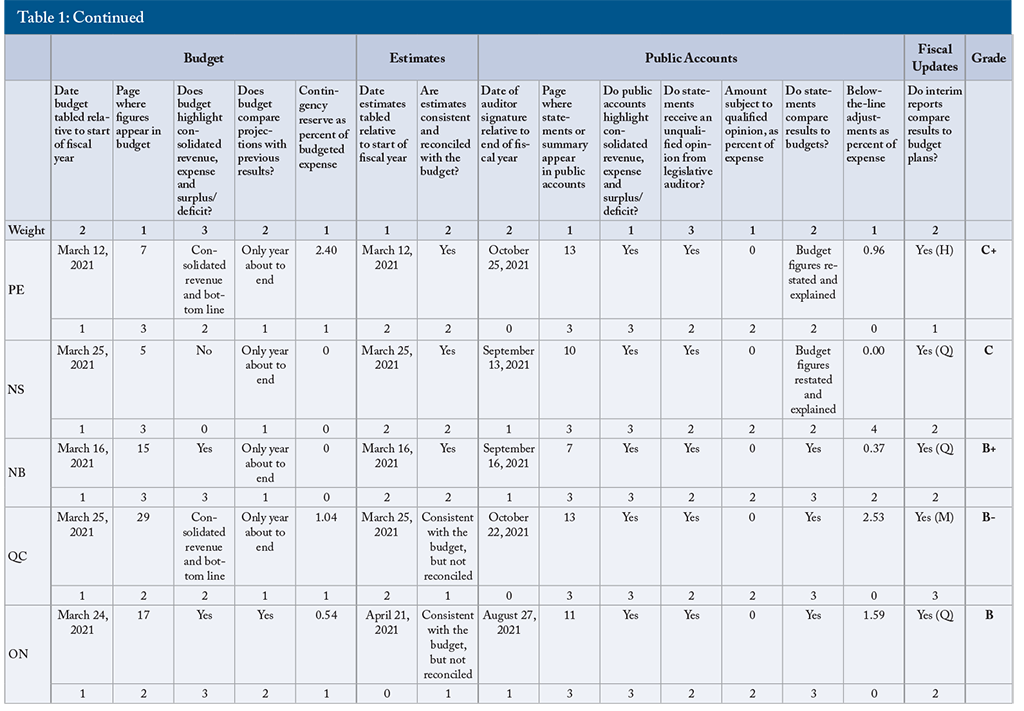
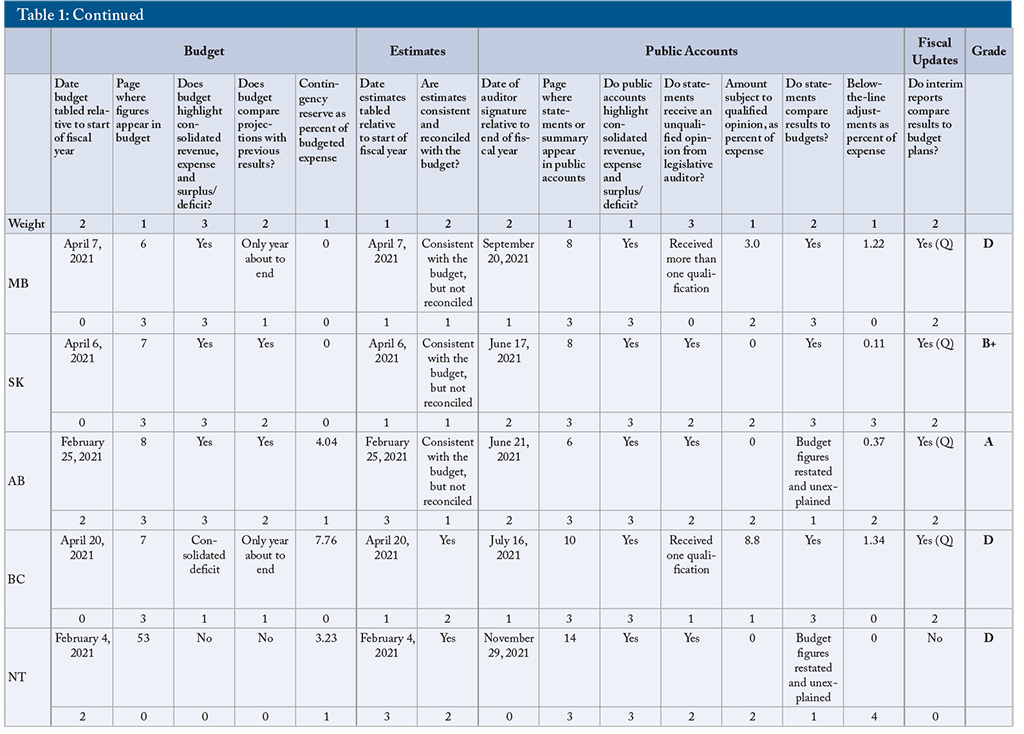
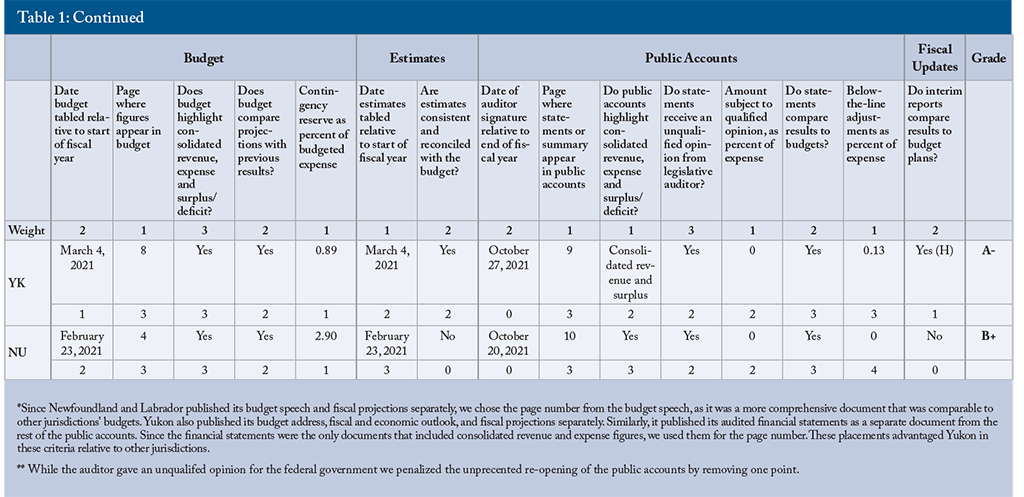
In the C tier are Prince Edward Island (C+) and Nova Scotia (C). Prince Edward Island did not present a consolidated expense figure in its budget. Nova Scotia did not highlight consolidated totals in its budget.
In the D tier are the federal government (D+), Newfoundland and Labrador (D+), Manitoba (D), British Colombia (D), and the Northwest Territories (D).
The federal government’s budget was late and buried the key numbers. It released its main estimates separately from the budget. Although the federal government received a clean audit opinion, the release of its public accounts was delayed by a reopening of the books to backdate some spending after the auditor general had already signed off – an unprecedented move that led us to deduct a point on that criterion. The federal government’s financial statements have recently highlighted a presentation without a figure for consolidated expense, showing actuarial losses related to its employee pensions below a conceptual “operational balance” line. This presentation implies that these actuarial losses resulted from circumstances outside the government’s control, which is misleading: they reflect the government’s use of an artificially high discount rate when it originally recorded the pension obligations (Laurin and Robson 2020). Although this amount appears in consolidated expenses, with other costs of federal employees, in some parts of the public accounts, its omission in the highlighted figures lowered the federal government’s grade.
Newfoundland and Labrador’s late budget and unreconciled estimates with different accounting lowered its score. Manitoba and BC had audit problems and BC had large contingency reserves. The Northwest Territories’ D- reflects several failures – among them, incomplete budget information buried deep in the document and no in-year report providing comparisons to budget plans.
Notwithstanding some recent setbacks, the quality of financial reporting by Canada’s senior governments has been on an improving trend – notably, better adherence to PSAS in financial statements and in budgets.
Before the establishment of PSAS in the 1980s, senior governments largely budgeted on a cash basis, recording revenues when cash flowed in and expenses when cash flowed out, even if the activity related to the receipts and payments did not occur in the relevant fiscal year. PSAS mandate accrual accounting, which matches revenues and expenses to the period when the relevant activity occurred. Amortizing long-lived assets over the period during which they deliver services, for example, is more informative than showing their up-front cash costs. Likewise, recording deferred compensation such as pensions for government employees as it accrues is more informative than showing it when the payments occur.
As Canada’s senior governments moved to PSAS in their year-end financial statements, they initially continued presenting budgets on a cash basis, resulting in potentially baffling discrepancies between the two documents. We are glad to report that most senior governments have recently presented budgets consistent with PSAS. As such problems have become less salient over time, our scrutiny in this project has extended to other issues.
In recent years, we added the criterion that governments should also present their estimates on a PSAS basis, and in a format that lets users easily reconcile them with budgets. We added a complementary criterion: that the main estimates should appear before the start of the fiscal year – ideally with budgets. We also revised the criteria related to the timing of budgets and financial statements, accentuating the difference between governments that present budgets early enough to permit substantive legislative scrutiny and those that do not, and between governments that publish their results promptly and those that do not. We refined the criteria related to adherence of the financial statements to PSAS in two ways. We differentiated between governments that received one auditor’s qualification, which might reflect a minor matter or an arguable difference in interpretation, from those with more than one – a warning about more chronic problems. We also took into account the size of discrepancies identified by the auditor. We added the criterion related to below-the-line adjustments, because they obscure the connection between a government’s annual results and changes in its service capacity, and give governments scope to de-emphasize results for which they would prefer not to be accountable.
In this year’s report, we adjusted our page-count criterion so as not to penalize tables of contents and lists of tables and figures. We adjusted our thresholds for below-the-line adjustments to reflect updated history.
Changes in criteria and weights can affect governments’ relative standings. We check the size of those impacts by comparing each government’s grade for 2022 with its grade for 2021, as published in last year’s report (Robson and Wu 2021) and with the grade it would have received in 2021 if that report had used this report’s scoring system (Table 2). Changes in criteria do matter, but most of the changes in grades between the two years reflect changes in governments’ financial reporting.
Extending this comparison with the past allows some more observations. New Brunswick has been a consistently high performer. New Brunswick has a particularly strong record in presenting timely budgets: for several years, it was unique in presenting a January budget, and it has consistently presented its budget before the start of the fiscal year.
Saskatchewan’s strong record is also worth noting. It joined the top performers in last year’s report due to timely presentations of its budget, estimates and public accounts. Although its 2021 budget was late, it has a relatively solid record, with budgets and public accounts that present the key numbers early, clean audits, and small below-the-line adjustments.
Yukon’s grade improved markedly this year. Presenting budgets consistent with financial statements contributed largely to Yukon climbing from a middling score to a top score.
British Columbia was an A-level performer in the past, but has slipped lately. The size of the discrepancy flagged by its auditor general is an ongoing problem, as is its below-the-line adjustment. A late budget that did not highlight consolidated revenue and expense and a large contingency reserve also contributed to a poorer grade this time.
Alberta has been a solid performer since 2015, when it stopped showing multiple balance figures in its budgets. It rejoined the top rank this year with a timely budget release. Provincial legislation requires Alberta’s budget to be tabled in February, a deadline it achieved in 2021/22.
Ontario’s B-level grade in 2019 was an improvement from previous years, when a qualified opinion from the provincial auditor general hurt it. It has not improved from that level, unfortunately, with a late budget and inconsistent timing and presentation of its main estimates being a problem this time.
The federal government’s grade improved from last year’s F, since it produced a budget. Excluding amortization of unrecognized pension costs from its expenses is a retrograde step, however. Its late public accounts and estimates presented using an inconsistent accounting standard also hurt it.
The 2022/23 Budget Cycle and a Preview of 2023 Results
Although the overall trend in fiscal transparency and accountability of Canada’s senior governments has been positive, the absence of a federal budget in 2020 and problems in the 2021 and 2022 budget rounds, including those just mentioned, show that improvement is not automatic.
The number of senior governments presenting timely documents increased in the 2022/23 budget cycle from the year before, with the federal government, Newfoundland and Labrador, Prince Edward Island, Quebec, Saskatchewan, Alberta, British Colombia, and Yukon all releasing budgets sooner than they did in 2021/22. Nunavut presented its estimates in May, but its consolidated budget is not yet available.
Ontario is a particular disappointment. It had a legal deadline of March 31 for its budget release, but amended the legislation in 2022 to extend the deadline to April 30 – a month after the fiscal year had begun.
We show preliminary grades for next year’s report card in Table 3. The preliminary grades reflect an update of the scores in Table 1, using 2022/23 budgets and estimates, and assuming each government’s performance on its 2021/22 public accounts will be the same as its performance in 2020/21. The final scores will depend on the timing and quality of each government’s public accounts, but judging from performance to date, Ottawa will get a D+ next year and Alberta will top the class with an A+.
Does Fiscal Accountability Matter?
Although transparent and timely financial reports alone cannot ensure that governments will serve the public interest, they are a crucial foundation. Without them, citizens and taxpayers, and the legislators who represent them, lack basic information about what governments are planning, how they performed relative to their plans, and the consequences of their performance for their future capacity to deliver services. With good numbers, citizens, taxpayers and legislators have a strong start in understanding fiscal plans, monitoring progress, and addressing problems.
Canada’s senior governments have a notable tendency to overshoot their budget targets: over the past couple of decades, both revenues and expenses have come in over budget projections far more often than not. This overshooting was less pronounced prior to the massive overshoots occasioned by the COVID crisis, but its cumulative effect meant that governments went into the crisis spending more than they would have been if they had hit their annual targets previously.
Our focus on presentation might appear remote from decisions that affect taxation and the quality of government services. Canada’s municipalities, however, offer examples of real-world consequences from problematic budget presentations. Municipal financial statements, like those of most senior governments, are consistent with PSAS. But their budgets typically were not in the past, and even now, many municipal budgets use cash accounting rather than accrual accounting in their capital budgets. The daunting up-front outlays councillors see in municipal budgets likely discourage capital investments in general, and encourage excessive up-front charges for the projects that do proceed. Annual angst over balancing their city’s budget is familiar to councillors, ratepayers and voters. Much less noticed are the sizable annual surpluses cities show in their financial statements, and cumulative surpluses sometimes accompanied by substantial holdings of financial assets (Robson and Wu 2022).
Budget presentations that are consistent with financial statements and that facilitate comparisons between intentions and results could help cities tax and spend more effectively; we think the correlation between consistent accounting and smarter decisions applies equally well to senior governments.
Disputes over Financial Reporting
Disagreements over financial presentations offer indirect but powerful testimony to their importance. Battles between governments and legislative auditors show that governments think the presentation of financial information matters: why risk a qualified opinion unless a misleading presentation offers some political reward?
When public sector accounting standards were newer in the 1990s, auditor reservations were more common. Salient examples occurred at the federal level in the late 1990s and early 2000s, when Ottawa pre-booked increasingly large amounts of spending, artificially reducing surpluses (Robson 1999; Robson and Omran 2020a). As the auditor general of Canada complained (see, for example, Canada 2001, 1.29-1.34), the federal government was showing Parliament financial statements that reflected neither what Parliament voted nor the government’s true fiscal position. Moreover, as in the municipal case, making decisions based on what will look good in the financial document distorted the actual allocation of resources. Ottawa ended up taxing more, and spending more on programs that lent themselves to financial manipulation, than it would have done had it shown better information.
Ontario provides more recent examples. In fiscal year 2015/16, the provincial auditor general issued a qualified opinion on Ontario’s financial statements because they showed pension plan assets that the government did not control. The following year, the auditor general also objected to the government’s consolidation of accounts of Ontario’s Independent Electricity System Operator, which brought other assets and liabilities outside the government’s control into Ontario’s Statement of Financial Position. Ontario’s 2017/18 financial statements, which garnered an unqualified opinion from the auditor general, showed a larger deficit than they would have if these practices had continued. Prior budgets and financial statements showing bigger deficits likely would have produced some mixture of spending restraint and more aggressive revenue collection than actually occurred.
An ongoing example is Quebec. Quebec’s auditor general has issued a qualified opinion on its financial statements for nine years, noting that the government was not properly reporting subsidies to third parties for the construction of fixed assets and other expenditures. The auditor estimates the resulting understatement of the province’s accumulated deficit at more than $12 billion. We understand that the province is addressing the auditor’s concerns, but think it possible that Quebec would have raised more revenue or cut expenses if it had complied with its auditor’s recommendations during this period.
The federal government improved from its failing grade in the 2021 report card. But it has introduced a new problem by moving the amortization of its unfunded pension liabilities out of compensation costs, and therefore out of the headline expense figures in its budgets, public accounts and fiscal monitors. Instead, it shows them as a charge below a conceptual “operational balance” line.
This presentation directs readers’ attention away from a major component of the cost of federal employees. The operating balance line overstates the government’s fiscal health. Although the net actuarial losses line is part of the annual deficit, and is not “below the line” like the other comprehensive income/loss entries we consider in our criterion, putting it below an “operational balance” tally gives it the appearance of something the government could not budget for or control. That is misleading: the main reason for this negative amount is that the government recorded its accruing pension obligations using a discount rate that is unreasonably high. Unfortunately, a deterioration in the federal government’s fiscal transparency – we note again its failure to produce a budget in 2020 – has accompanied a massive increase in its deficits and debt.
Improving Fiscal Accountability in Canada
On the positive side, many of Canada’s senior governments have improved their financial presentations, and before COVID had tended to achieve results closer to their budget projections. On the negative side, there is continuing tension between the requirements of good financial reports and obscure, misleading, or missing numbers. We conclude this year’s report with some suggestions to foster better transparency and accountability.
All Documents Should Reflect Public Sector Accounting Standards
All Canada’s senior governments should publish financial statements that are consistent with public sector accounting standards, and highlight consolidated revenues, expenses, and surplus or deficit. All other documents, including budgets, in-year updates on the evolving situation and reconciliation tables explaining differences between projections and outcomes, should likewise be consistent with those standards and highlight the same key numbers.
Budgets Should Precede the Start of the Fiscal Year
Budgets should be timely, giving legislators and citizens time to understand and respond to – and, in the case of legislators, vote on – the fiscal plan before the year is already under way. It is an affront to accountability to ask legislatures to approve a plan after money has already been spent. Public engagement will suffer if lack of time precludes an opportunity to understand and comment on a budget’s projections before the fact. It should be superfluous to remark that all governments should present budgets, but since the federal government did not in 2020/21, we say it anyway. And all governments should present their budgets before the end of February. Timeliness is particularly important in the case of the federal government, since transfers from it to provinces and territories are material in provincial and territorial budgets.
Estimates Should Be Timely and Reconcile with Budgets
Governments that show estimates inconsistent with their budgets and/or their financial statements create an information gap for legislators. Inconsistencies might result from different accounting and/or aggregation, and from legislators’ not receiving information showing whether expenses authorized by votes on individual programs reconcile with the fiscal plan. Showing consolidated expenses on the same accounting basis as the budget, with clear reconciliation of any aggregation differences between the estimates and the budget, mitigates this problem. In recent years, the federal government improved the presentation of its estimates, providing reconciliations with the budget plan and showing the relevant expenses on an accrual basis.
An additional problem is that legislators sometimes get, and vote on, estimates that are not synchronized with the budget. Several Atlantic provinces set a good example, releasing estimates consistent with budget projections simultaneously with their budgets. All governments should present their main estimates in February, at the same time as their budgets.
This is an area where legislators should play a stronger role by using powers they already possess. The federal, provincial and territorial legislatures all have standing committees to deal with estimates, such as the federal House of Commons Standing Committee on Government Operations and Estimates. Modern centralized communications and control in the offices of premiers and prime ministers can make this committee work seem unexciting and low profile. But the salience of budget numbers is likely to increase in coming years, with the increasing cost of servicing much larger debt, upward pressure on demographically sensitive program costs, and revenue constrained by slow real economic growth. Now would be a good time for legislators to raise the profile of this work.
Key Numbers Should Be Accessible and Recognizable
Relevant and accurate numbers are less useful if readers cannot find them or recognize them when they do find them. Clearly labelled numbers in the opening pages of a document help understanding and engagement. Obscure numbers hundreds of pages deep, or in an annex, do not.
In this connection, we urge governments to declutter their budgets. The federal government sets a terrible example: while many provinces put their key budget numbers up front, Ottawa has for years buried them in an annex, after hundreds of pages of political spin, repetition, and irrelevant material. Experts know to persist until they find the summary statement of transactions that includes the effects of the budget measures. A non-expert exploring the budget might give up before finding it, or think such obscure numbers must not be important. Ottawa features the key figures prominently and early in its financial statements; it should follow that good example in its budgets.
The presentation of prudent financial cushions and contingency reserves also requires attention. While we prefer explicit amounts to less transparent approaches such as downward-biased revenue projections, the amounts must be reasonable in size and presented as part of the fiscal plan in a format that indicates they are there to protect a target for the surplus or deficit, and are not actual cash amounts for a government to spend as it pleases.
Year-End Results Should Be Timely
Every organization needs timely information to detect and fix problems. The public accounts of Canada’s senior governments let legislators and citizens compare end-of-year results with budget plans to see if the government fulfilled its promises and to understand the size of, and reasons for, deviations from targets. Quick production of financial statements encourages faster gathering and compilation of data, which should improve the quality of the numbers in the budget plan for the year underway and, by extension, for the baseline fiscal position in the future.
At the beginning of this century, the OECD (2002) recommended the publishing of audited financial statements no more than six months after year-end, to allow legislators to scrutinize the prior year’s outcomes before voting on the next budget. With improvements in information technology since then, we think this is a reasonable outside limit and that a best-practice standard would be faster.
Alberta requires its public accounts to appear before the end of June. Most governments, however, receive their auditor’s approval and produce their reports far later. Ontario’s legislated date for tabling its public accounts is 180 days after the end of the fiscal year: September 27th. Manitoba’s is September 30th. The federal government’s legislated date for tabling its public accounts is December 31st, which is too late. The Parliamentary Budget Office, in criticizing the December 2021 release of the 2020/21 Public Accounts, recommended the end of September as a new deadline (PBO 2022). Why not the end of August, July, or even June? In our view, September 30th should be the latest date on which any government tables and releases its public accounts, with releases before the end of June being ideal.
Legislators Should Review the Public Accounts
Finally, we underline the importance of legislative involvement at the end of the fiscal cycle, as well as at the beginning. With the exception of Quebec, every senior legislature has a standing committee on public accounts.
Like the committees dealing with estimates, the public accounts committees typically do not generate a high profile for their members. But that low profile partly reflects the reluctance of these committees to flex their muscles. The attention garnered by reports of legislative auditors – and by this annual C.D. Howe Institute report card – shows that people who insist on transparency and accountability for public funds can make a difference.
Legislative scrutiny can help ensure that below-the-line adjustments are rarer, and used more appropriately, than they otherwise might be. Public sector accounting standards mandate them for gains and losses of Crown corporations that would not be appropriately shown in the statement of operations, but that does not mean legislators and taxpayers should ignore them, or accept them as inevitable. If a Crown corporation is hurting a government’s ability to achieve its budget goals, perhaps the government should reform it or dispose of it.
Canada’s Senior Governments Can and Should Do Better
Governments play a massive role in the Canadian economy and in the lives of Canadians. The chains of accountability that link citizens’ wishes, through their elected representatives, with the officials who tax, regulate and serve them are long and complicated, and transparency and accountability in fiscal policy are essential. For many years, the trend in the quality of financial reporting by Canada’s senior governments was up. More recently, the fiscal response to COVID and a casual attitude toward public money has produced some deteriorations in governments’ fiscal positions and deteriorations in the quality of financial reporting. This is no time for fiscal policy to become more opaque. An intelligent and motivated, but non-expert, citizen seeking to understand a government’s current situation and plans should be able, quickly and confidently, to find the key figures in budgets, estimates and public accounts. That citizen should be readily able to see what that government plans to do before the year starts and compare that with what it did shortly after the year has ended. As this report card shows, governments that do not meet these standards could make some straightforward changes that would improve the situation. The grades of the top performers reflect consolidated financial statements consistent with PSAS, and budgets, estimates and interim reports prepared on the same basis. All governments can do that. They also reflect presentations that make the key numbers readily accessible early in the relevant documents. All governments can do that. And they reflect timely presentations: budgets presented before the fiscal year starts and public accounts tabled shortly after fiscal year-end. All governments can do that. There is no mystery to the challenge. If Canadians insisted on better financial reporting from their governments, they could get it.
Appendix
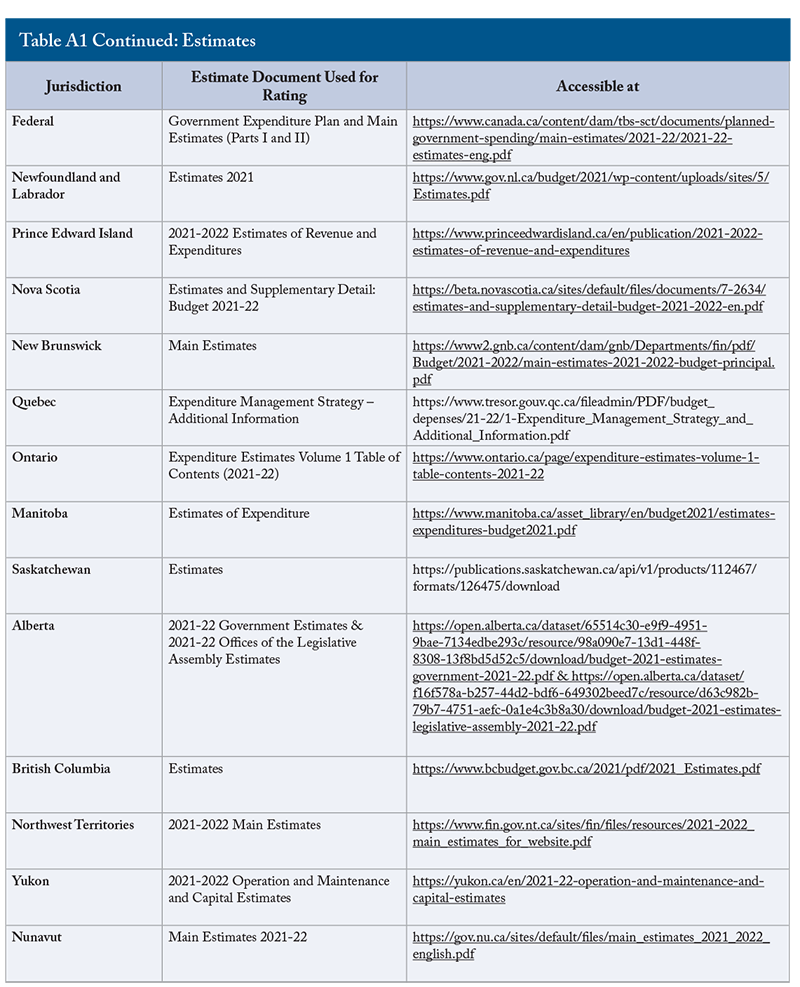
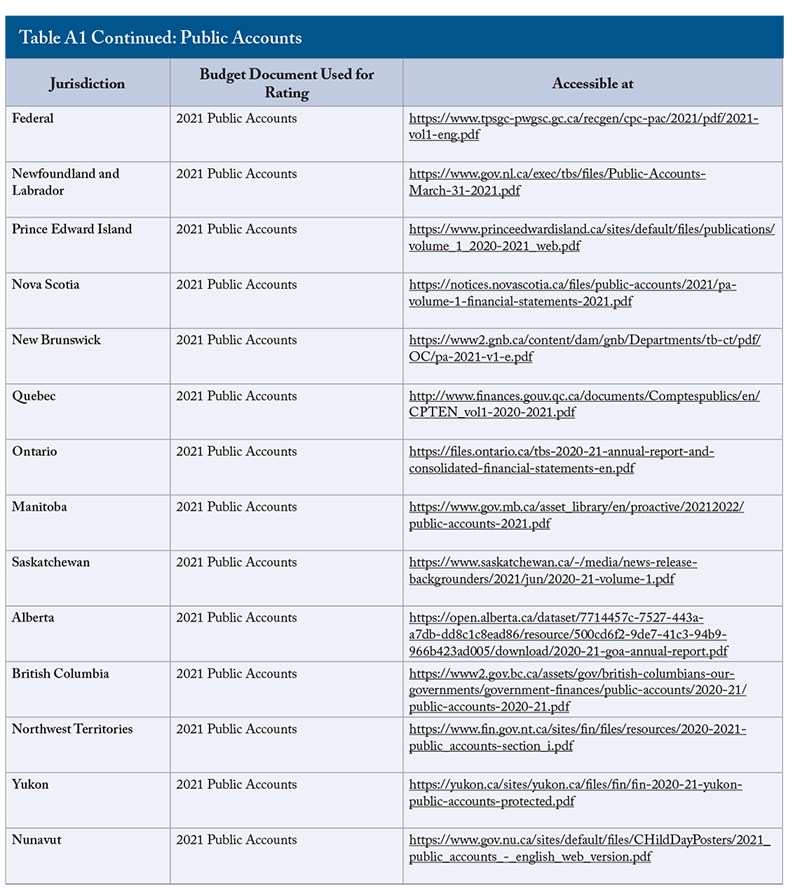
References
Canada. 2001. Receiver General for Canada. Public Accounts of Canada 2001, Vol. 1. Ottawa. September.
Ferguson, Michael. 2017. “Why Is More Attention Not Paid to Government Financial Statements?” Presentation to the CPA Canada Public Sector Conference, Ottawa, October 23.
International Budget Partnership. 2020. “The Open Budget Survey, 2019.” Washington, DC. March.
Laurin, Alexandre, and William B.P. Robson. 2020. “Under the Rug: The Pitfalls of an ‘Operating Balance’ Approach for Reporting Federal Employee Pension Obligations.” E-Brief. Toronto: C.D. Howe Institute. November.
Organisation for Economic Co-operation and Development (OECD). 2002. “OECD Best Practices for Budget Transparency.” Paris.
Parliamentary Budget Office. 2022. Economic and Fiscal Update 2021: Issues for Parliamentarians. Ottawa. January.
Public Sector Accounting Board. 2021. “Financial Statement Presentation, Proposed Section PS 1202.” Toronto. Exposure Draft. January.
Robson, William B.P. 1999. “Hiding the Good News: Ottawa’s Book-Cooking Is a Troubling Sign for the Future.” Backgrounder. Toronto: C.D. Howe Institute. February.
____________. 2020. There Is No Try: Sustainable Healthcare Requires Reining in Spending Overshoots. Commentary 566. Toronto: C.D. Howe Institute. February.
Robson, William B.P., and Miles Wu. 2021a. Good, Bad, and Incomplete: Grading the Fiscal Transparency of Canada’s Senior Governments, 2021. Commentary 607. Toronto: C.D. Howe Institute, September.
____________. 2021b. Trouble on the Bottom Line: Canada's Governments Must Produce More Reliable Budgets. Commentary 611. Toronto: C.D. Howe Institute. November.
____________. 2022. Solving the Municipal Budget Mystery: Fiscal Accountability in Canada's Cities, 2021. Commentary 617. Toronto: C.D. Howe Institute. February.
